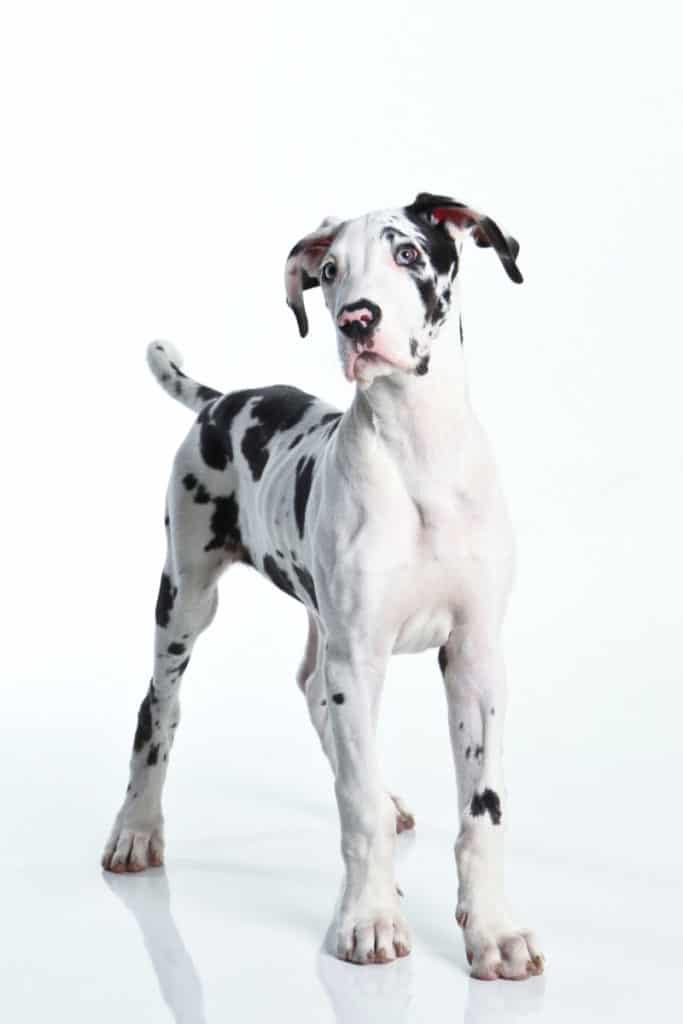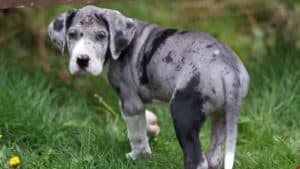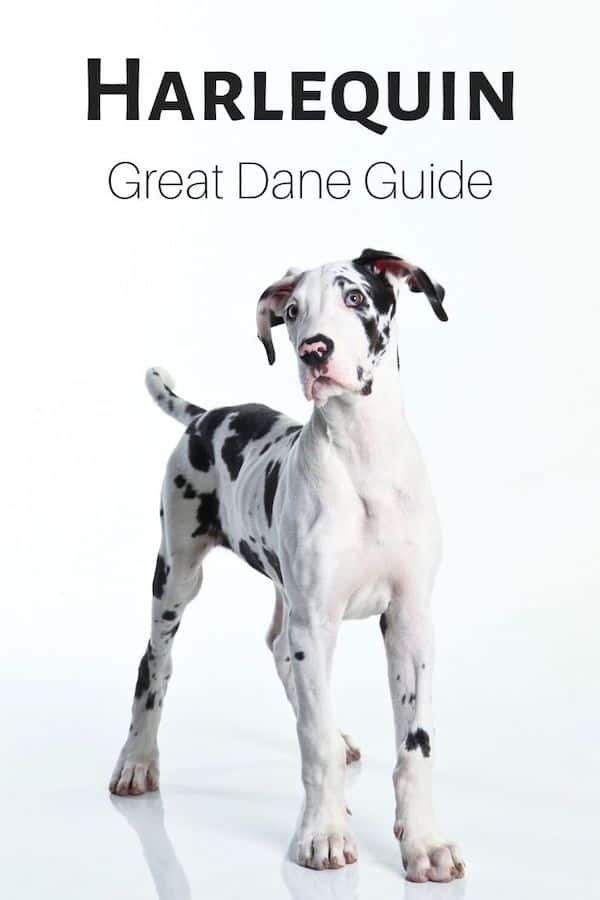
The Harlequin Great Dane is a striking and distinctive breed that has captured the hearts of dog enthusiasts worldwide. Whether you’re a proud Harlequin Great Dane owner or simply curious about this majestic breed, join us as we explore everything you need to know about these remarkable dogs.
A Harlequin Great Dane has a white base color coat with irregularly shaped black patches evenly distributed across the body. It is one of the seven officially recognized Great Dane colors, and Great Danes with a Harlequin coat are sometimes mistaken for Dalmatians due to the coat similarity.
In this article, we’ll delve into the unique characteristics, history, and care considerations of the Harlequin Great Dane, shedding light on what makes them so fascinating and beloved among dog lovers.
Table of Contents
AKC Standard for Harlequin Great Danes
In addition to the white base coat with black torn patches, there are a few additional marking preferences/notes defined in the breed standard for a Harlequin Great Dane.
Some of these are considered requirements for the dog to fall into the Harlequin classification for show, while others are simply listed as preferable.

- Markings should have torn (jagged) edges instead of being completely round
- There should be neither too few or too many patches. Balance to the coat is key
- Patches should not be so large as to appear to create a blanket on the coat
- Black patches may appear on the chest and legs as well
- Merle patches are also normal
- A pure white neck is preferred
- It’s considered less desirable when black hairs are showing through the white base coat
As you can see, there is a lot of room for variation in the Harlequin Great Dane coat!
While breeders should take certain steps to avoid breeding mismarked Harlequin Danes, there’s still no guarantee that even the most careful of breedings will not result in litters producing at least some puppies with mismarkings.
For owners, these marking guidelines are really only relevant if you intend to show the dog. If your only interest is in finding a fantastic family pet for your home, then you have little need to worry about the specific nature of these markings.
You will be much better served by picking a dog whose personality is a good fit instead of selecting one based on a particular “look”.
While some Harlequin Danes may look similar, no two will have identical coats. This can make for a fun sense of pride and appreciation for your “extra” unique Great Dane 😉
What is the difference between a Harlequin and a Merle Great Dane?
The primary difference between a Harlequin and a Merle Great Dane is in their base coat color. While a Harlequin has a white base coat, Merle Great Danes have a pale to dark gray Merle base color.
On top of this gray coat, they will also have sections of torn black patches.

Other common markings of a Merle Great Dane include:
- White and black spotting
- White chest
- Whole or partial white neck
- White on whole or part of fore and hind legs
While these two coats are similar, the difference in base coat color makes it fairly easy to tell them apart.
Given this close appearance, it shouldn’t come as a surprise that their coat color genetics are also very close!
However, because the topic of color coat genetics is complex, I’d recommend taking a look at this article from doggenetics.co.uk for a more in-depth read into it if you’re interested.
Are Harlequin Danes born with spots?
Yes, Harlequin Great Dane puppies are born with spots!
However, these spots may change shape, shift around, and even grow as the dog gets older.
Given that Great Dane puppies typically weigh 1-2 pounds and are well over 100 pounds as adults, that’s a lot of growth to account for, and should come as no surprise that the spots change.
You can expect the dog’s coat to “finalize” once they reach adulthood. This usually happens around the 2-3 year mark for most Harlequins.
However, there are also reports of coats changing as late as 5+ years, so don’t let it concern you if this does end up being the case for your dog.
In addition to the changes in their spots, you may also see a change in the dog’s nose color. Many puppies initially have a cute pink nose that turns to black as the dog grows solder.
Helpful articles
Can you breed two Harlequin dogs?
Even two perfectly marked and healthy Harlequins cannot, or rather should not, be bred due to the risk of a resulting double merle gene.
Because each Harlequin carries the gene, it’s almost guaranteed that some of the pups from the litter will have the double merle.
Why does having a double merle matter?
Sadly, while many double merles do not survive birth, those who are born are commonly blind and/or deaf. Each dog in the litter bred from two Harlequin Great Danes has a 25% chance of carrying the double gene.
For easy math, a litter of 8 dogs would likely result in 2 with the double merles. One would likely not survive birth, while the other would likely be born severely impaired.
While two Harlequins should not be bred together, other acceptable approaches to breeding/producing the Harlequin coat color have far less risk.
Below are a few approaches commonly taken to safely producing litters containing Harlequin puppies, or dogs whose coats resemble that of a Harlequin.
- Harlequin + Mantle (preferred approach)
- Black + Harlequin
- Mantle + (Harlequin-bred) Black
- Black + Black (when both blacks are Harlequin-bred)
Note: some of these combinations are more likely to produce mismarked Harlequin coats than others.
How much is a Harlequin Great Dane?
Where you purchase a Harlequin will have more impact on the price than the color itself.
For example, if you were to purchase a Harlequin from a shelter then it’s highly likely that they would cost the same as any other Great Dane color from the same shelter.
Shelter adoption fees vary by region, but you can expect to pay somewhere in the $300 – $400 range for a puppy. Older dogs usually cost a little less.
If you are purchasing the Harlequin from a breeder then the fees will likely be much higher than a shelter adoption. This will vary breeder by breeder, but generally, you can expect to pay between $1,800 – $3,000 for a Harlequin Great Dane.
For a given breeder, you may find that their Harlequin puppies are slightly more expensive than other colors.
I say “slightly” because if you’re already considering paying ~$2,000 for a dog, then an additional few hundred probably isn’t a deal-breaker but it is worth noting.
The reason for this increase is that the breeding of Harlequin Danes requires an even more methodical approach than normal.
Because their markings are so varied, it can be difficult to find dogs that meet both the health and marking requirements.
While mismarked dogs can be bred, most breeders seek to breed the Great Danes who best exemplify the breed standard.
What is a Merlequin Great Dane?
Merlequins look very similar to that of a Harlequin Great Dane coat, with the exception of the color of their black patches.
These patches are instead replaced by patches of merle i.e. blue with black dots.
Because the appearance takes on the blend of a Harlequin and Merle coat, the name “Merlequin” is used to describe these Great Danes.
Great Dane Health and Lifespan
Great Danes are generally healthy dogs with a lifespan of 7 to 10 years.
However, like all giant breed dogs, they are susceptible to certain health issues that owners should be aware of.
Common Diseases
Great Danes are prone to several diseases, including hip dysplasia, blindness, heart diseases, autoimmune thyroiditis, and hypothyroidism.
Hip dysplasia is a genetic condition that affects the hip joint, causing pain and lameness. Blindness can be caused by a variety of factors, including genetics and old age.
Heart diseases are common in large breeds and can be fatal if not treated promptly. Autoimmune thyroiditis is a condition where the immune system attacks the thyroid gland, leading to hypothyroidism.
Hypothyroidism can cause a range of symptoms, including weight gain, lethargy, and skin problems.
Lifespan
Great Danes have a relatively short lifespan compared to other breeds, with an average lifespan of 7 to 10 years.
Proper care and attention can help extend their lifespan and ensure they live a healthy and happy life. This includes regular exercise, a healthy diet, and regular check-ups with a veterinarian.
Owners should also be aware of the risk of bloat, a potentially life-threatening condition that can occur when a dog’s stomach fills with gas and twists on itself.
Signs of bloat include restlessness, pacing, and a distended abdomen. If left untreated, bloat can be fatal to dogs.
Adoption and Purchase
Adopting a Great Dane can be a rewarding experience for both the dog and the owner. There are many options available for those looking to adopt a Harlequin Great Dane, including shelters and rescue organizations.
Adopting a shelter or rescue can be a great way to provide a home for a dog in need.
Shelters and rescues often have Great Danes available for adoption. Adoption fees can vary depending on the organization and the dog’s age, health, and other factors.
However, adopting a dog from a shelter or rescue can be a more affordable option than purchasing a dog from a breeder.
Purchasing a Harlequin Great Dane from a breeder can be a more expensive option, but it can also provide more control over the dog’s lineage, temperament, and health. It is important to do research and find a reputable breeder who prioritizes the health and well-being of their dogs.
When bringing a Harlequin Great Dane home, it is important to provide a safe and comfortable environment for the dog.
Harlequin Great Danes are large dogs and require ample space to move around. They also require regular exercise and mental stimulation.
Harlequins can make great companions for those who have the space and resources to care for them properly.
Whether adopting or purchasing, it is important to approach the process with care and consideration for the dog’s well-being.
Harlequin FAQs
What is a harlequin great dane?
A Harlequin Great Dane is a specific color variant of the Great Dane breed, characterized by a unique coat pattern of irregular black patches over a white base pattern.
This distinct appearance results from specific genetic influences, and though the pattern may be visually striking, it does not affect the breed’s overall health, temperament, or physical capabilities.
Are Harlequins the biggest Great Danes?
Harlequin Great Danes are not necessarily the largest; size in Great Danes does not depend on color but rather on genetics and individual growth patterns.
On average, adult Great Danes, regardless of their color, stand about 28-34 inches at the shoulder and can weigh anywhere between 100-200 pounds.
are harlequin danes aggressive?
Harlequin Great Danes, like all Great Danes, are typically not aggressive by nature and are known for their gentle and affectionate disposition.
However, like any breed, individual temperament can vary, and proper socialization and training from a young age is crucial to ensure a well-adjusted, healthy, and friendly Harlequin Great Dane.
what is the rarest color of great dane?
The rarest color of Great Dane is considered the white Great Dane, due to the specific genetic combination required to produce this coloring.
However, it’s important to note that white Great Danes often suffer from health problems like deafness and blindness, making it an undesirable trait among breeders.
Can you breed two harlequins together?
While it is technically possible to breed two Harlequin Great Danes together, it is generally not recommended due to the complex genetics involved in creating the Harlequin pattern, which is associated with various health issues.
Breeding two Harlequins can increase the risk of producing puppies with deafness, blindness, and other serious health problems, so ethical breeders typically avoid this pairing.
Conclusion
In conclusion, the Harlequin Great Dane is a unique and impressive breed that is known for its distinctive black and white spotted coat pattern.
They are loyal and affectionate companions that make great family pets.
It is important to note that the Harlequin Great Dane is not the same as the Mantle Great Dane. While they may look similar, the Harlequin has a white neck and pure white chest, while the Mantle has a black “blanket” over its body with a white neck and chest.
Overall, the Harlequin Great Dane is a beautiful and unique breed that is sure to turn heads wherever it goes. With the right care and attention, these gentle giants can make wonderful companions for families of all sizes!


Very nice to meet you Mr. Zach! I’ve loved, GREAT DANES, for as long as I can remember. I want a Harlequin with blue eyes ( one blue eye will be just as lovable! ) I live in Florida. Would you mind suggesting an appropriate breeder for me to get my beautiful DANE? It would be GREATLY appreciated!
Hello! I’d recommend taking a quick look at our breeder page here -> https://greatdanecare.com/great-dane-breeders-near-you/